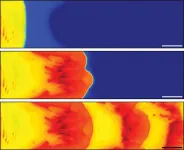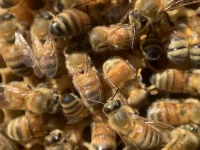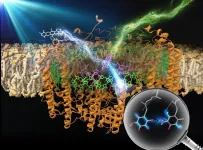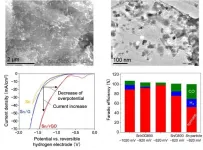(Press-News.org) Floating solar farms could help to protect lakes and reservoirs from some of the harms of climate change, a new study suggests.
However, given the complex nature of water bodies and differing designs of solar technologies, there could also be detrimental ecosystem impacts of deploying floating solar arrays.
Conventional solar farms are controversial due to the amount of land they take up. This is leading to increasing interest in floating solar farms - making use of the additional space that bodies of water provide.
So far, there are three commercial-size floating solar arrays in the UK, and hundreds more across the world. The number of installations is likely to grow significantly in coming decades as demand rises for renewable energy sources with more countries committing to net zero carbon targets.
However, little is known about the impacts - both positive and negative - these floating solar farms are having on the lakes and reservoirs they are installed on - until now.
Scientists from Lancaster University and the University of Stirling have completed the first detailed modelling of the environmental effects of floating solar installations on bodies of water.
"As demand for land increases, water bodies are increasingly being targeted for renewable energy. Deployment of solar on water increases electricity production, but it is critical to know if there will be any positive or negative environmental consequences," said Mr Giles Exley, PhD researcher and lead author from Lancaster University.
"Given the relative immaturity of floating solar farms, it is important to further scientific evidence of the impacts. Our results provide initial insight of the key effects that will help inform water body manager and policy maker decisions."
The research team undertook computer modelling using the MyLake simulation programme and data collected by the UK's Centre for Ecology and Hydrology from England's largest lake, Windermere. Although the researchers believe it is unlikely floating solar farms will be deployed on Windermere, it presents a rich data-set as it is one of the most comprehensively studied lakes in the world.
Their results show that floating solar arrays can cool water temperatures by shading the water from the sun. At scale, this could help to mitigate against harmful effects caused by global warming, such as blooms of toxic blue green algae, and increased water evaporation, which could threaten water supply in some regions.
The scientists found that floating solar installations also reduce the duration of 'stratification' - this is where the sun heats the water, forming distinct layers of water at different temperatures. This tends to happen more in the warmer summer months and can result in the bottom layer of water becoming deoxygenated, which deteriorates water quality - an obvious issue for supplies of drinking water. However, the picture is complex and there are also conditions under which stratification, and therefore detrimental water quality impacts, could increase if floating solar farms are deployed.
Mr Exley said: "The effects of floating solar on the temperature of the water body and stratification, both of which are major drivers of biological and chemical processes, could be comparable in magnitude to the changes lakes will experience with climate change. Floating solar could help to mitigate against the negative effects global warming will have on these bodies of water."
"However, there are also real risks of detrimental impacts, such as deoxygenation causing undesirable increases in nutrient concentrations and killing fish. We need to do more research to understand the likelihood of both positive and negative impacts."
The effects on water temperature increased the larger the solar installation, with small arrays of less than ten per cent of the lake surface generally having minimal impacts. However, this model concentrated on one lake. Further studies will be needed to determine the optimum size array, and design, and their effects for individual lakes and reservoirs - all of which have unique characteristics. Different designs of solar installations also have different shading and sheltering effects for the sun and wind.
Arrays covering more than 90 per cent of a lake could increase the chances of the lake freezing over in winter, the study found - though these effects would also be specific to the body of water and design of the installation and require further studying.
Field studies and further modelling work to build on these initial findings is ongoing.
INFORMATION:
'Floating photovoltaics could mitigate climate change impacts on water body temperature and stratification', has been published by the journal Solar Energy.
The paper's authors are Giles Exley, Alona Armstrong and Trevor Page from Lancaster University, and Ian Jones from the University of Stirling.
For scientists, especially graduate students, who conduct fieldwork, every day is precious. Researchers meticulously prepare their equipment, procedures and timelines to make sure they get the data they need to do good science. So you can imagine the collective anxiety that fell across academia in spring 2020 when COVID-19 struck and many universities suspended in-person activities, including fieldwork.
But for Austin Green, a doctoral student in the School of Biological Sciences and 2019 recipient of a National Geographic Society Early Career Grant, who studies the wildlife that lives in the canyons of the Wasatch Front, that anxiety was tempered by the knowledge that pandemic or no pandemic, his network of automated ...
The largest flightless bird ever to live weighed in up to 600kg and had a whopping head about half a metre long - but its brain was squeezed for space.
Dromornis stirtoni, the largest of the 'mihirungs' (an Aboriginal word for 'giant bird'), stood up to 3m high and had a cranium wider and higher than it was long due to a powerful big beak, leading Australian palaeontologists to look inside its brain space to see how it worked.
The new study, just published in the journal Diversity, examined the brains of the extinct giant mihirungs or dromornithid birds that were a distinctive part of the Australian fauna for many millions of years, before going extinct around 50,000 ...
During the COVID-19 pandemic, people have grown accustomed to wearing facemasks, but many coverings are fragile and not easily disinfected. Metal foams are durable, and their small pores and large surface areas suggest they could effectively filter out microbes. Now, researchers reporting in ACS' Nano Letters have transformed copper nanowires into metal foams that could be used in facemasks and air filtration systems. The foams filter efficiently, decontaminate easily for reuse and are recyclable.
When a person with a respiratory infection, such ...
Nature produces a startling array of patterned materials, from the sensitive ridges on a person's fingertip to a cheetah's camouflaging spots. Although nature's patterns arise spontaneously during development, creating patterns on synthetic materials is more laborious. Now, researchers reporting in ACS Central Science have found an easy way to make patterned materials having complex microstructures with variations in mechanical, thermal and optical properties -- without the need for masks, molds or printers.
In animals, patterns form before birth ...
Honeybees play a scent-driven game of telephone to guide members of a colony back to their queen, according to a new study led by University of Colorado Boulder. The research, published today in the Proceedings of the National Academy of Sciences, highlights how insects with limited cognitive abilities can achieve complex feats when they work together--even creating what looks like a miniature and buzzing version of a telecommunications network.
The findings also serve as a testament to a honeybee's love for its queen. These matriarchs are the most important members of any hive: They're the only females able ...
Given the finite nature of fossil fuel reserves and the devastating environmental impacts of relying on fossil fuels, the development of clean energy sources is among the most pressing challenges facing modern industrial civilization. Solar energy is an attractive clean energy option, but the widescale implementation of solar energy technologies will depend on the development of efficient ways of converting light energy into chemical energy.
Like many other research groups, the members of Professor Takehisa Dewa's research team at Nagoya Institute of Technology in Japan have turned to biological photosynthetic apparatuses, which ...
[Background]
Decreasing the emission and efficient utilization (fixation) of carbon dioxide (CO2) are worldwide issues to prevent global warming. Promotion of the use of renewable energy is effective in reducing CO2 emissions. However, since there are large time-dependent fluctuations and large regional differences in renewable energy production, it is necessary to establish a fixation technology to allow efficient energy transportation and storage. Thus, there is increasing interest in technologies for synthesizing useful chemicals from CO2 using electricity derived from renewable energy. ...
A new study suggests that Sargramostim, a medication often used to boost white blood cells after cancer treatments, is also effective in treating and improving memory in people with mild-to-moderate Alzheimer's disease. This medication comprises of a natural human protein produced by recombinant DNA technology (yeast-derived rhu GM-CSF/Leukine®).
The study, from the University of Colorado Alzheimer's and Cognition Center at the University of Colorado Anschutz Medical Campus (CU Anschutz), presents evidence from their clinical trial that shows that Sargramostim may ...
(Boston)--Being persistently lonely during midlife (ages 45-64) appears to make people more likely to develop dementia and Alzheimer's Disease (AD) later in life. However, people who recover from loneliness, appear to be less likely to suffer from dementia, compared to people who have never felt lonely.
Loneliness is a subjective feeling resulting from a perceived discrepancy between desired and actual social relationships. Although loneliness does not itself have the status of a clinical disease, it is associated with a range of negative health outcomes, including sleep disturbances, depressive symptoms, cognitive impairment, and stroke. Still, feeling lonely may happen to anyone at some point in life, ...
A new study shows that if the population were fixed at current levels, the risk of population displacement due to river floods would rise by ~50% for each degree of global warming. However, if population increases are taken into account, the relative global flood displacement risk is significantly higher.
The research, by an international team from Switzerland, Germany, and the Netherlands, used a global climate-, hydrology- and inundation-modelling chain, including multiple alternative climate and hydrological models, to quantify the effect of global warming on displacement ...






